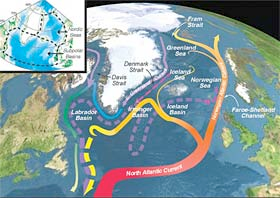By John
Roach
for National Geographic News
June 27, 2005
Global Warming May Alter Atlantic Currents,
Study Says
In the 2004 eco-disaster film The Day After Tomorrow, Europe and North
America are gripped by a deep freeze after global warming halts the
circulation of a North Atlantic ocean current. The film is pure Hollywood
hyperbole.
But some scientists say the current is vulnerable to rising temperatures.
Acting like a conveyor belt, the current transports warm, surface
waters toward the Poles and cold, deep waters toward the Equator.
In the Atlantic Ocean, these warm surface waters push northward, releasing
heat into the atmosphere and becoming cooler and denser. As they do,
the waters sink and flow southward in the deep ocean.
"The Atlantic circulation moves heat toward the Arctic, and this
helps moderate wintertime temperatures in the high-latitude Northern
Hemisphere," said Ruth Curry, a physical oceanography research
specialist at the Woods Hole Oceanographic Institution on Cape Cod,
Massachusetts.
Curry noted that excessive amounts of freshwater dumped into the North
Atlantic could alter seawater density and, in time, affect the flow
of the North Atlantic ocean current. (Global warming has boosted freshwater
runoff in the form of glacier meltwater and additional precipitation,
Curry said.)
Just how much extra freshwater it would take to alter the circulation
system, known as the Atlantic Meridional Overturning Circulation, is
a gray area of climate science.
Broken Belt?
Suffice it to say that the conveyor belt continues to work today.
But freshwater runoff into the North Atlantic has increased in recent
decades, and runoff is expected to increase further as global temperatures
climb higher, Curry said.
Curry and research colleague Cecilie Mauritzen of the Norwegian Meteorological
Institute in Oslo estimate that it will take about a century, at present
rates, for the circulation pattern to be seriously affected by the
increase in freshwater runoff.
The scientists conclude that it would take about two centuries for
freshwater runoff to halt the North Atlantic conveyor belt entirely.
Curry and Mauritzen published their findings in the June 17 issue of
the research journal Science.
Stefan Rahmstorf, a professor of ocean physics at Potsdam University
in Germany, said the researchers' calculations appear accurate.
But he emphasized that their findings do not provide a forecast; they
only give an impression of the amount of freshwater required to alter
or halt the North Atlantic ocean current.
"It is of course very unlikely that the freshening [freshwater
inflow] will simply continue at the same rate it has for the past few
decades," he wrote in an e-mail to National Geographic News.
|

A map of Nordic seas and subpolar basins shows the circulation
of surface currents (solid curves) and deep currents (dashed curves)
that form a portion of the Atlantic Meridional Overturning Circulation.
Much like a conveyor belt, the climate-regulating ocean pattern transports
warm surface waters toward the north and cool, deep waters toward the
south. Credit: Jack Cook, Woods Hole Oceanographic Institution
Rahmstorf said the freshening could be part of a natural fluctuation
in Earth's climate system that will stop and reverse.
He added, however, that if the phenomenon is due to global warming,
which he said is likely, then the freshening will probably accelerate
as glaciers melt and more rain falls at high latitudes in response to
rising temperatures.
Unpredictable Climate
According to Curry, scientists are uncertain as to the exact course
global warming will take and how it will affect the amount of freshwater
flowing in the North Atlantic. A particular wild card, she noted, is
Greenland.
"As it does melt, it will release freshwater into the Nordic seas"—water
bodies found between Iceland, Greenland, and Norway—"and that
probably represents the biggest source of freshwater that could have
an impact on the conveyor belt," she said.
There are a number of mechanisms that could inject large amounts of
freshwater into the Nordic seas at the precise region that is critical
to the conveyor belt. They include
• pooling and release of glacial meltwater,
• collapse of an ice shelf followed by a surge in glacier movement, or
• lubrication of a glacier's base through increased melting.
According to an unpublished survey by Potsdam University researchers
Kirsten Zickfeld and Anders Levermann, expert scientific opinion varies
widely on the likelihood that excess freshwater runoff from the Arctic
will alter the North Atlantic conveyor belt in this century.
Some scientists consulted for the survey said there is no chance that
the current will break down. Others estimated that the chance of a complete
shutdown exceeds 50 percent if global warming climbs by 7.2° to 9° Fahrenheit
(4° to 5° Celsius) by 2100.
Rahmstorf believes the chance of a circulation shutdown is as high as
30 percent. He said any possibility of such a scenario, even if slight,
is cause for concern.
"Nobody would accept expanding nuclear power if there was a 5 percent
risk of a major accident," he said. "Why would we accept expanding
oil and coal power if there is a 5 percent risk of a major climate accident?"
Source: National Geographic |


